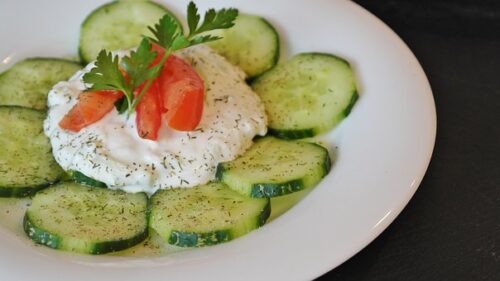Tzatziki is a popular Greek dip made from yogurt, cucumbers, and various herbs and spices. Tzatziki is a traditional Greek dip that’s made from strained yogurt, grated cucumber, garlic, olive oil, and various herbs and spices like dill, mint, and parsley. It’s a refreshing and tangy dip that’s often served with pita bread or used as a sauce for grilled meats or vegetables. It’s a popular dish in Mediterranean cuisine and has gained popularity all around the world.
Ingredients of Tzatziki
The ingredients of tzatziki can vary depending on the recipe and region, but the most common ingredients include:
- Greek yogurt or strained yogurt
- Cucumber
- Garlic
- Olive oil
- Lemon juice
- Dill
- Mint
- Parsley
- Salt and pepper
Is Tzatziki Vegan?
The answer to this question depends on the recipe and ingredients used to make tzatziki. Traditional tzatziki is not vegan because it contains yogurt, which is made from dairy milk. However, there are vegan alternatives to tzatziki that use non-dairy yogurt or tofu instead of dairy yogurt.
Vegan Alternatives to Tzatziki
If you’re following a vegan diet, there are plenty of alternatives to traditional tzatziki that you can try. Some vegan alternatives to tzatziki include:
- Cashew-based tzatziki: made with soaked cashews, lemon juice, garlic, and herbs.
- Tofu tzatziki: made with silken tofu, lemon juice, garlic, and herbs.
- Non-dairy yogurt tzatziki: made with non-dairy yogurt like coconut or soy yogurt, cucumber, garlic, and herbs.
Nutritional Value of Tzatziki
Tzatziki is a nutritious dip that’s rich in protein, healthy fats, and various vitamins and minerals. One serving (2 tablespoons) of traditional tzatziki contains:
- Calories: 23
- Protein: 2g
- Fat: 2g
- Carbohydrates: 1g
- Fiber: 0g
- Sodium: 30mg
- Calcium: 2% of the Daily Value (DV)
- Vitamin C: 1% of the DV
Benefits of Tzatziki
Tzatziki has several health benefits due to its nutritious ingredients. Some potential benefits of tzatziki include:
- Boosts gut health: the probiotics in yogurt help improve digestion and support a healthy gut microbiome.
- May reduce inflammation: garlic and herbs like dill and mint have anti-inflammatory properties that may help reduce inflammation in the body.
- Good source of protein: tzatziki is a good source of protein, which is essential for building and repairing tissues in
Benefits of Tzatziki
the body and for maintaining muscle mass.
- Provides calcium: tzatziki is a good source of calcium, which is important for bone health.
- Low in calories: tzatziki is a low-calorie dip that can be a healthier alternative to other high-calorie dips like ranch or sour cream-based dips.
How to Make Vegan Tzatziki
If you’re following a vegan diet, you can still enjoy the refreshing taste of tzatziki with a few substitutions. Here’s a recipe for vegan tzatziki:
Ingredients:
- 1 cup unsweetened plain yogurt (non-dairy)
- 1/2 cucumber, grated and squeezed to remove excess moisture
- 1 clove garlic, minced
- 1 tablespoon lemon juice
- 1 tablespoon chopped fresh dill
- 1 tablespoon chopped fresh mint
- Salt and pepper to taste
Instructions:
- In a medium-sized bowl, whisk together the yogurt, grated cucumber, minced garlic, lemon juice, dill, and mint.
- Season with salt and pepper to taste.
- Cover and chill in the refrigerator for at least 30 minutes before serving.
Vegan Recipes that Use Tzatziki
Tzatziki is a versatile dip that can be used in a variety of vegan recipes. Here are a few ideas:
- Veggie wraps: fill a tortilla with roasted vegetables, quinoa, and tzatziki for a delicious and nutritious lunch.
- Falafel bowl: top a bowl of cooked quinoa or rice with falafel, roasted veggies, and a dollop of tzatziki.
- Greek salad: toss together lettuce, tomatoes, cucumbers, olives, and a drizzle of tzatziki for a refreshing salad.
Is Tzatziki Healthy for You?
Tzatziki can be a healthy addition to your diet, but it depends on the ingredients used to make it. Traditional tzatziki is made with full-fat dairy yogurt, which is high in saturated fat and calories. However, you can make a healthier version of tzatziki by using low-fat yogurt or non-dairy yogurt. Additionally, the cucumber and herbs used in tzatziki provide a range of vitamins and minerals.
Can You Use Different Herbs in Tzatziki?
Absolutely! While dill and mint are the traditional herbs used in tzatziki, you can experiment with different herbs to suit your taste preferences. Some other herbs that work well in tzatziki include parsley, cilantro, and basil.
What Are Some Toppings for Tzatziki?
Tzatziki is a versatile dip that can be used in a variety of ways. Some toppings that pair well with tzatziki include chopped tomatoes, olives, feta cheese (for non-vegan versions), and chopped nuts.
What Are Some Alternatives to Tzatziki?
If you’re looking for an alternative to tzatziki, there are a few options. Hummus is a popular dip that is similar to tzatziki in texture but has a different flavor profile. Baba ganoush is another dip that is made from roasted eggplant and has a smoky flavor. Additionally, guacamole is a dip that is made from avocado and is a great alternative for those following a vegan diet.
Can You Make Tzatziki Spicy?
Yes, you can add some spice to your tzatziki by adding chili flakes or chopped jalapenos. Alternatively, you can use a spicy seasoning blend like harissa or za’atar to add some heat to your tzatziki.
Conclusion
In conclusion, traditional tzatziki is not vegan because it contains yogurt, which is made from dairy milk. However, there are plenty of vegan alternatives to tzatziki that use non-dairy yogurt or tofu instead of dairy yogurt. Vegan tzatziki is a nutritious and delicious dip that can be used in a variety of vegan recipes.

